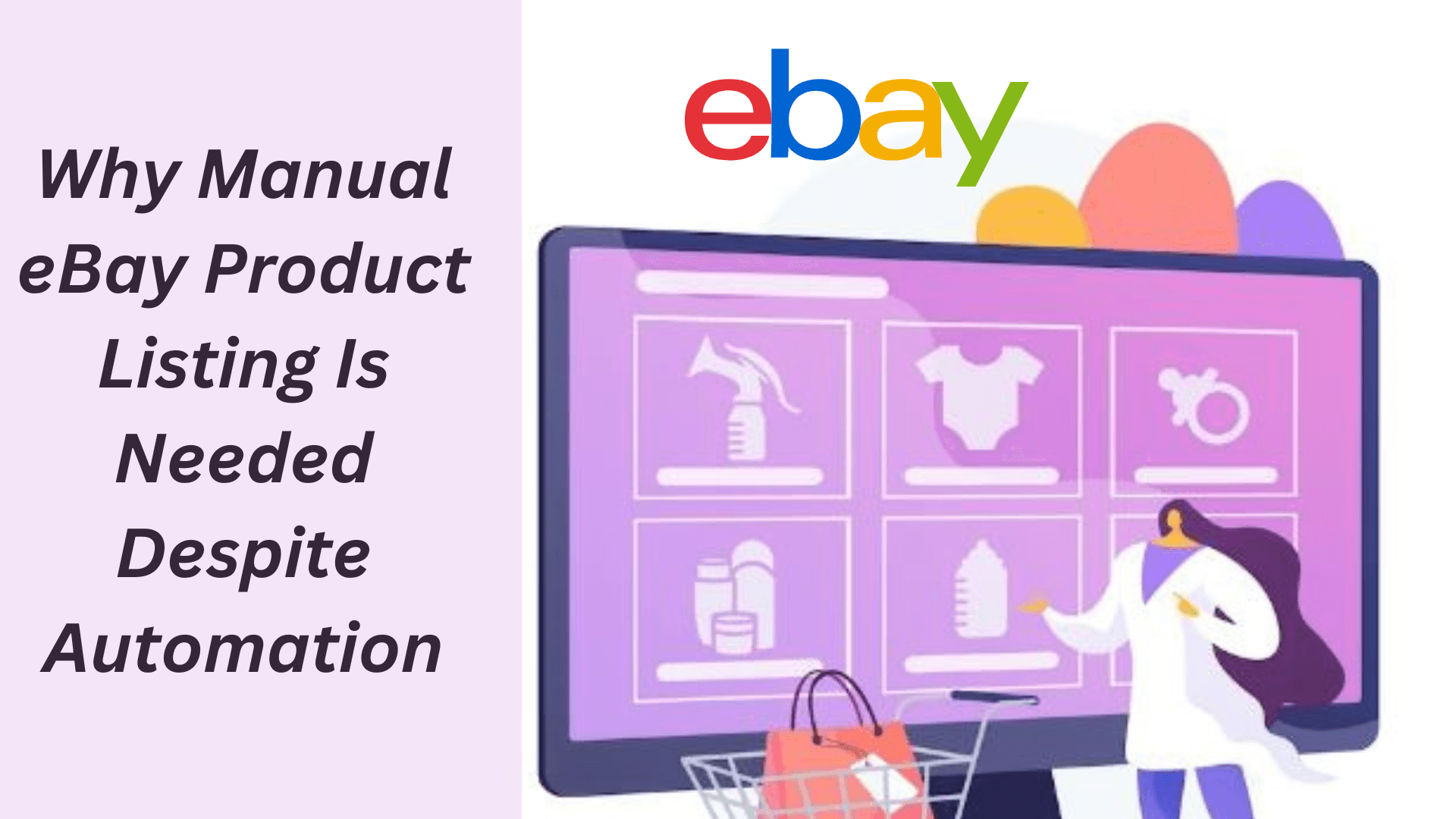In the ever-advancing realm of online business, eStore owners are constantly seeking ways to streamline their operations and stay ahead of the competition. In this, automation has emerged as a powerful way that allows businesses to cut down costs, save valuable time, and optimize their processes. Automation tools simplify complex tasks, enhance efficiency, and help achieve greater scalability and profitability. However, while automation offers numerous benefits, it is important to recognize the value of human involvement, especially when it comes to crucial eStore management tasks such as product listing.
When processes such as product listing creation involve human expertise, it brings a level of care, attention to detail, and creativity that cannot be replicated by automated systems alone. Manual involvement allows sellers to craft compelling product descriptions, ensure accurate categorization, and customize listings to suit their target audience.
In this post, we will explore the reasons why eBay sellers should not overlook the significance of manual intervention when creating product lists, and how it complements automation by delivering unique benefits to their online businesses. We will also understand how opting for professional eBay product upload services can help in this regard.
Why Manual eBay Product Listing Outshines Automation
Sellers are opting for AI tools for their eBay product listing needs due to the benefits of automation, such as cost savings, ease of maintenance, timely completion of work, and more. And in the process, they may overlook some of the drawbacks of doing so, as AI is still not up to the mark on many fronts.
Below, you will find information on the different aspects of product listing and the limitations of AI in these.
1. Product Title and Description Writing
Generative AI applications like ChatGPT can now create any kind of text a user wants based on simple prompts. This ability has made the creation of product descriptions for eCommerce pages a breeze. Such tools can scour the internet for information on the product in question and prepare a draft title and description in a matter of minutes. This swiftness and fairly accurate description of products without costs has made such tools an enticing addition to the cause of eBay automation.
The problem is that these automated tools fall short in several aspects. They provide generic and repetitive content, which can potentially include plagiarism or duplicate content, thereby contradicting the principles of search algorithms. Additionally, the lack of creativity in the content makes it monotonous and unattractive. Consequently, this negatively impacts sales, as user engagement declines and reduces the likelihood of conversions.
Therefore, human intervention is necessary when creating titles and descriptions as they ensure clarity, accuracy, and relevance to the specific product being described. It also allows for customization and tailoring of the content to suit the target audience, taking into account their preferences and behavioral patterns. Hence, the resulting descriptions are more effective in communicating the product’s features and benefits, leading to improved customer engagement and potential sales.
2. Product Image Enhancement
Generative AI has been making waves in all industries due to its ability to create any kind of content a user wants in no time with just a few prompts. This includes bespoke images with a variety of subject matter in them, along with the desired visual elements. This ability has come as a boon for the eCommerce sector, which is heavily dependent on product images to sell items.
The traditional method of getting product images is to hire a professional photography team to take pictures of the product in the desired way and then edit them to get the required result. Automation can simplify this job by producing those altered images with just the schematic provided by the manufacturer of the product.
However, the drawback here is that the AI tools can’t get the emotions that the seller wants to convey to the target audience right. Even if an image of acceptable quality is produced by the tool after many prompts, it may still need some editing to get the specifics just right for product upload. Moreover, If you want particular features like your brand logo’s watermark or a border reflecting your brand theme’s colors, AI tools alone cannot provide the level of customization you need. You require the expertise of a professional photo editor to create a tailored image that meets your specifications.
3. Product Taxonomy
Automated tools for categorizing products simplify and streamline the product taxonomy process by leveraging machine learning algorithms to analyze vast amounts of product data, such as descriptions, attributes, and specifications. These algorithms can identify patterns, keywords, and relevant information, allowing them to suggest appropriate categories for each product. By doing so, they accelerate the classification process and ensure consistent and accurate categorization across a large inventory.
However, in some cases, automated systems may not accurately understand the intricacies and nuances of certain industries or product types. While automation has undoubtedly revolutionized the eCommerce landscape, it is essential to recognize that human buying habits are often complex and influenced by various factors that automated systems might struggle to comprehend. For instance, organizing and presenting products to consumers in a way that aligns with their preferences and expectations.
To overcome these issues, it is wise to combine automated systems with human expertise. Manual curation and oversight of product categorization and taxonomy can provide valuable insights and ensure that the automated systems are aligned with human preferences and expectations. Human intervention can help identify new trends, update categories, and make adjustments based on feedback from customers, enhancing the overall shopping experience.
Choosing Manual Intervention over Automated Product Listing: Additional Benefits
Besides product listing creation, manual intervention can also be beneficial over automation in related areas. Several of them are discussed below.
1. Pricing Optimization
Using automation to find optimal price points involves gathering relevant data, analyzing it using advanced algorithms and machine learning models, and testing and optimizing pricing strategies. The analysis is generally based on the listed prices of an item across seller platforms. Automated tools recommend a price based on this data. However, it cannot gauge the market’s mood, leading to you missing out on a profit-making opportunity with the wrong price point it provides.
An eBay product listing professional, meanwhile, will have years of experience that the automation tool cannot match. This is coupled with their ability to predict the target market’s mood, leading to them creating pricing strategies that’ll keep your business afloat while keeping costs low enough to attract customers.
2. Inventory Management
Under and over-stocking is the real fear for any eCommerce store owner. Effective inventory management helps sellers optimize their stock levels. Hence, to save time and effort, sellers have started automating this process. AI tools can automatically update inventory levels as items are sold, reducing the chances of overselling or disappointing customers with out-of-stock products.
While automation tools offer numerous benefits, there are scenarios where a seller might prefer manual inventory management over automation. For sellers with a small number of products or a low sales volume, manually managing inventory may be more practical and cost-effective. Additionally, sellers with unique or custom-made products often require personalized attention, which may not be feasible with automation tools designed for standard inventory management.
When sellers opt for professional manual inventory management, they enjoy direct control and flexibility, allowing them to give each item the attention and care it deserves.
Conclusion
Even though using AI tools for product listing has advantages such as saving time and enhanced efficiency, among others, it is still a process that can be largely effective when carried out by humans. eBay sellers require a certain level of help from professionals to manually handle the automated tools and perform crucial tasks. To address the dilemma of manual versus automated, store owners have the option to either hire an in-house professional team or outsource eBay product listing services to experts.
Getting your products listed on the portal via a competent eBay listing professional can help overcome the drawbacks of eBay automation tools and promote your brand on the site and beyond. It’ll help drive more web traffic and conversions to your business while keeping your ROI on the better side.
Author Bio:
Jessica Campbell is an eCommerce consultant and content strategist. She has published over 2000 articles & informative write-ups about eCommerce & Amazon marketplace solutions covering Amazon listing optimization, Amazon PPC management services, Amazon SEO & marketing, Amazon store setup, and Amazon product data entry. Her well-researched and valuable write-ups have helped thousands of businesses uncover rich insights, strengthen their business processes, and stay afloat amidst the rising competition.


